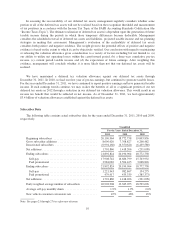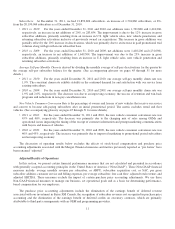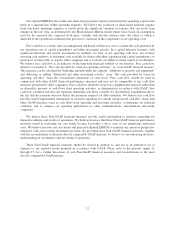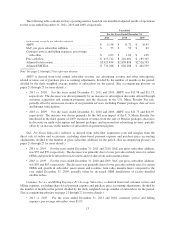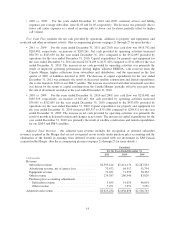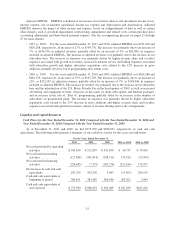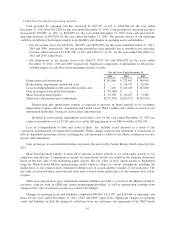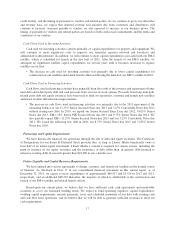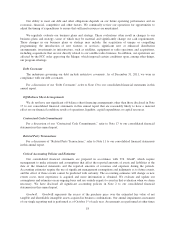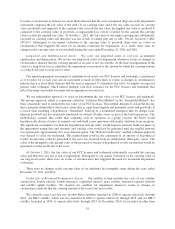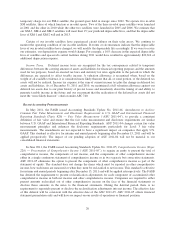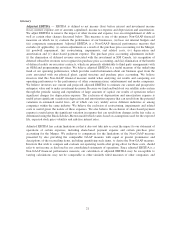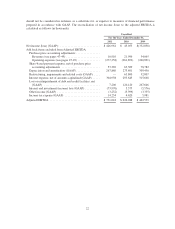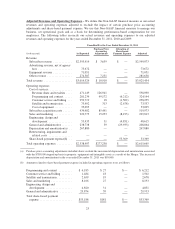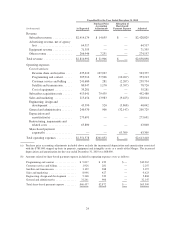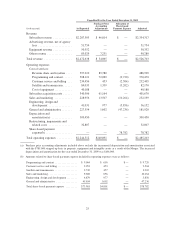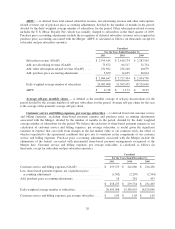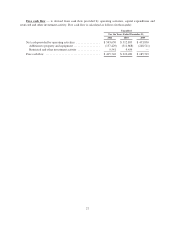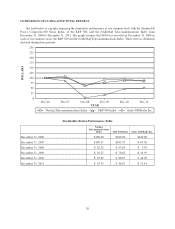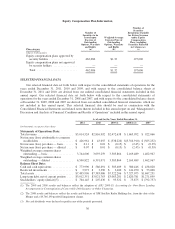XM Radio 2011 Annual Report Download - page 76
Download and view the complete annual report
Please find page 76 of the 2011 XM Radio annual report below. You can navigate through the pages in the report by either clicking on the pages listed below, or by using the keyword search tool below to find specific information within the annual report.temporary charge for our FM-4 satellite, the ground spare held in storage since 2002. We operate five in-orbit
XM satellites, three of which function as in-orbit spares. Two of the three in-orbit spare satellites were launched
in 2001 and the other in 2010 while the other two satellites were launched in 2005 and 2006. We estimate that
our XM-3, XM-4 and XM-5 satellites will meet their 15 year predicted depreciable lives, and that the depreciable
lives of XM-1 and XM-2 will end in 2013.
Certain of our in-orbit satellites have experienced circuit failures on their solar arrays. We continue to
monitor the operating condition of our in-orbit satellites. If events or circumstances indicate that the depreciable
lives of our in-orbit satellites have changed, we will modify the depreciable life accordingly. If we were to revise
our estimates, our depreciation expense would change. For example, a 10% decrease in the expected depreciable
lives of satellites and spacecraft control facilities during 2011 would have resulted in approximately $20,614 of
additional depreciation expense.
Income Taxes. Deferred income taxes are recognized for the tax consequences related to temporary
differences between the carrying amount of assets and liabilities for financial reporting purposes and the amounts
used for tax purposes, based on enacted tax laws and statutory tax rates applicable to the periods in which the
differences are expected to affect taxable income. A valuation allowance is recognized when, based on the
weight of all available evidence, it is considered more likely than not that all, or some portion, of the deferred tax
assets will not be realized. Income tax expense is the sum of current income tax plus the change in deferred tax
assets and liabilities. As of December 31, 2011 and 2010, we maintained a full valuation allowance against our
deferred tax assets due to our prior history of pre-tax losses and uncertainty about the timing of and ability to
generate taxable income in the future and our assessment that the realization of the deferred tax assets did not
meet the “more likely than not” criterion under ASC 740.
Recent Accounting Pronouncements
In May 2011, the FASB issued Accounting Standards Update No. 2011-04, Amendments to Achieve
Common Fair Value Measurement and Disclosure Requirements in U.S. GAAP and International Financial
Reporting Standards (Topic 820) — Fair Value Measurement (“ASU 2011-04”), to provide a consistent
definition of fair value and ensure that the fair value measurement and disclosure requirements are similar
between U.S. GAAP and International Financial Reporting Standards. ASU 2011-04 changes certain fair value
measurement principles and enhances the disclosure requirements particularly for Level 3 fair value
measurements. The amendments are not expected to have a significant impact on companies that apply U.S.
GAAP. This standard is effective for interim and annual periods beginning after December 15, 2011 and will be
applied prospectively. The impact of our pending adoption of ASU 2011-04 will not be material to our
consolidated financial statements.
In June 2011, the FASB issued Accounting Standards Update No. 2011-05, Comprehensive Income (Topic
220) —Presentation of Comprehensive Income (“ASU 2011-05”), to require an entity to present the total of
comprehensive income, the components of net income, and the components of other comprehensive income
either in a single continuous statement of comprehensive income or in two separate but consecutive statements.
ASU 2011-05 eliminates the option to present the components of other comprehensive income as part of the
statement of equity. The standard does not change the items which must be reported in other comprehensive
income, how such items are measured or when they must be reclassified to net income. This standard is effective
for interim and annual periods beginning after December 15, 2011 and will be applied retrospectively. The FASB
has deferred the requirement to present reclassification adjustments for each component of accumulated other
comprehensive income in both net income and other comprehensive income. Companies are required to either
present amounts reclassified out of other comprehensive income on the face of the financial statements or
disclose those amounts in the notes to the financial statements. During the deferral period, there is no
requirement to separately present or disclose the reclassification adjustments into net income. The effective date
of this deferral will be consistent with the effective date of the ASU 2011-05. ASU 2011-05 affects financial
statement presentation only and will have no impact on our results of operations or financial position.
20


